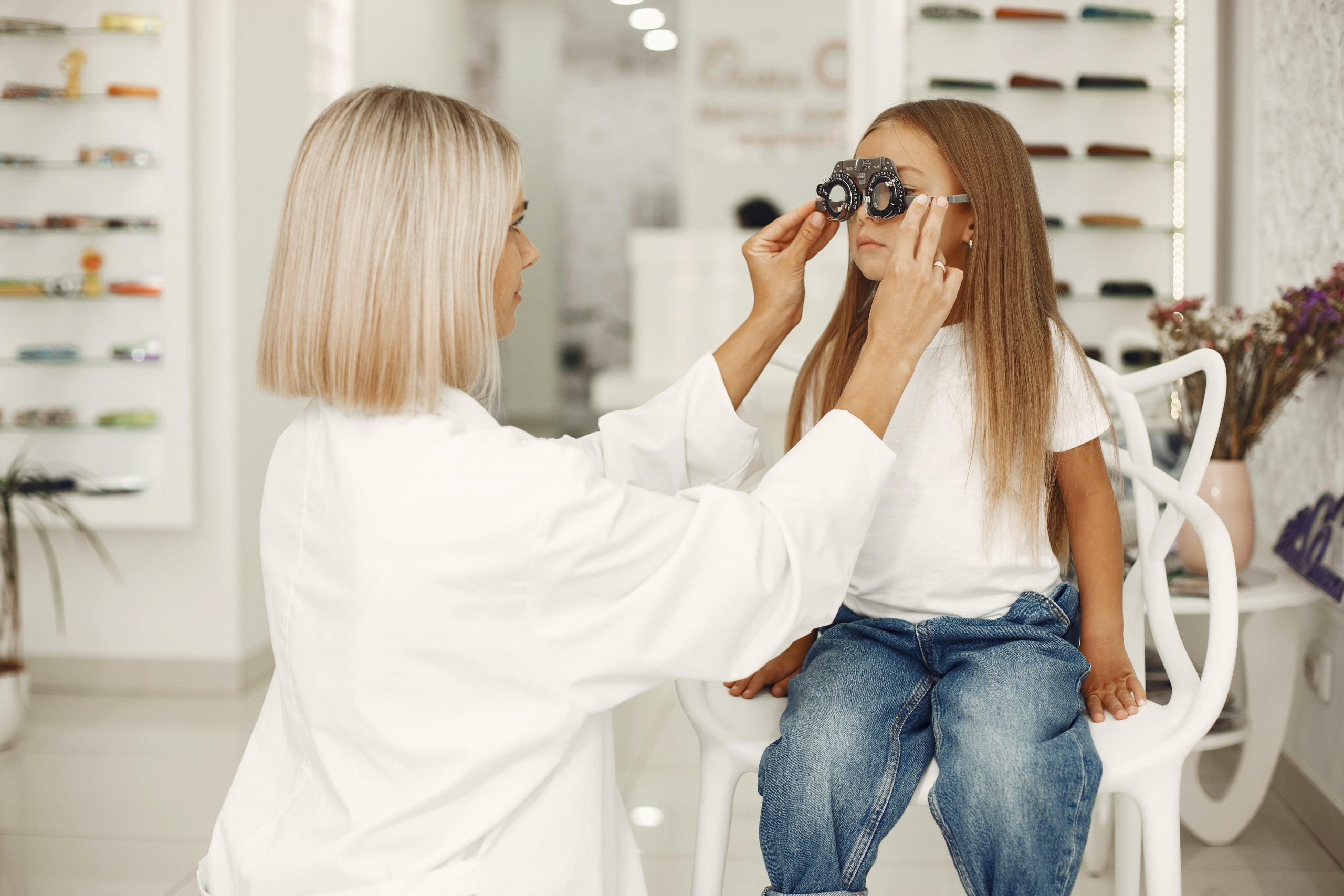
When you sit in your optometrist’s chair for a comprehensive eye exam you know that the goal is to have at least 20/20 vision.
But what does 20/20 vision really mean? (Hint, it DOES NOT mean perfect vision)
Read on to understand what 20/20 vision is and how you can achieve optimal vision with the help of corrective lenses!
What Is 20/20 Vision?
 You might be surprised to learn that having 20/20 vision means you have normal vision. There are many people that see 20/15 (which is better than 20/20).
You might be surprised to learn that having 20/20 vision means you have normal vision. There are many people that see 20/15 (which is better than 20/20).
With 20/20 vision, you can see things from 20 feet away that a normal person can see from 20 feet away.
How Is Vision Measured?
Routine eye exams are the most common place where vision is measured.
In-office optometrist exams are the most accurate option and will also give you greater insight into your overall eye health.
Eye Examination
An eye examination is a comprehensive exam that looks at the health of your overall eye in addition to testing your vision. Eye exams can identify underlying health problems related to the eyes as well as in other parts of your body.
As a part of the exam, you will also find out how well you see and if you need corrective lenses.
Visual Acuity Testing
When you have an eye exam you will do a visual acuity test. The visual acuity test will help an optometrist understand how well your eyes work.
Visual acuity tests use charts. The three most common charts are the:
- Snellen Chart
- Tumbling E-chart
- LEA Symbols Chart
Snellen Eye Chart

The Snellen Eye Chart is the most standard chart used for visual acuity tests. It has 11 rows of capital letters that get smaller with each progressing row. You will read different rows on the chart with both eyes together and each eye separately to see how well your eyes work alone and together.
Tumbling E-Chart
Dr. Snellen also created the Tumbling E-Chart, though it doesn’t bear his name. The E-Chart was created for individuals who don’t know the Roman alphabet. This chart uses only the letter E in 4 different directions so patients can use three fingers to demonstrate which direction the E is facing.
This test makes sure that individuals aren’t saying the wrong letter name due to knowledge instead of poor eyesight.
LEA Symbols Chart
The LEA Symbols chart was created by Dr. Lea Hyvärinen with young children in mind. This chart uses common pictures or shapes instead of letters. Children who haven’t learned letters yet find this system much easier.
The symbols become progressively smaller on each line in the same way that the letters do on a Snellen or Tumbling E chart.
Children can either say the name of what they see or point to the symbol they see on a key next to them during the exam.
The results of your visual acuity test will tell you if you have 20/20 vision or a different numeric representation.
Visual Acuity Scores Explained
Once you have completed your visual acuity test your doctor will tell you what your vision is. You will be given two numbers.
This is the part that people don’t often understand. The first number is how far from the chart you were and the second number is the distance from the chart someone with normal vision can be and still see the same line clearly.
The first number is usually 20 and this means that your eyes were tested 20 feet away from the chart.
Smaller doctor’s offices can use a mirror or other techniques to make the chart appear 20 feet away without it actually being 20 feet away. In these situations, your number is still 20 if things are manipulated correctly.
The second number is how far away from the chart the average person can see the same last line you read. Most charts designate the second to bottom line as the 20/20 line.
20/20 vision means that you viewed the test from 20 feet away and an average person can read to the same point on the vision chart at 20 feet away.
The smaller the second number, the better your vision is. Someone with 20/15 vision has better than 20/20 vision. This means they can see at 20 feet away what an average person can see clearly at 15 feet away.
The larger the second number, the worse your vision is. In the case of 20/40 vision, someone can see something at 20 feet away that a normal-sighted person can see sharply at 40 feet away.
Your vision acuity score is used in conjunction with other elements to decide what your corrective lens prescription should be.
Common Vision Problems
Other vision problems can affect the need for glasses. They can also impact the type of lenses you will be prescribed and whether you have 20/20 vision or not.
Myopia
Myopia is more commonly known as nearsightedness. Individuals with myopia see well close up, but have a difficult time seeing further away.
Individuals with mild myopia might not need glasses or will only need them in certain situations. It isn’t uncommon for patients with myopia to have a pair of glasses for driving, performances or movies where they’re seated far away, or sports that require the ability to see far away.
If you have myopia you might be told to not wear your glasses when you read or do anything close to your face. You can get headaches or weaken your vision when you wear glasses and they aren’t needed.
Hyperopia
Hyperopia is the opposite of myopia. If your eyes are hyperopic you have a harder time seeing things close to you than things that are further away.
If you’ve ever seen someone hold a book further from their face to see it better they probably have hyperopia.
Someone with hyperopia will have reading glasses that they only need to use when close-range vision is important.
Astigmatism
A defect in the cornea or lens causes astigmatism. When the cornea or lens isn’t perfectly round astigmatism occurs.
Patients with astigmatism have blurry vision at every distance and need glasses or contacts all the time.
Age-Related Macular Degeneration
Age-related macular degeneration (AMD) is very common in adults as they become middle-aged.
AMD varies between people. Some people have mild degeneration and will only need corrective lenses part-time. Others will need a strong prescription at all times.
AMD is preventable with good habits in younger decades.
All of these diseases and others that are less common will affect your visual acuity and influence what treatment plan will be necessary.
Achieving and Maintaining 20/20 Vision
A lot of elements of our eye health are genetic. We can’t control everything or guarantee that we can maintain 20/20 vision our entire lives. But we can treat our eyes well and prevent unnecessary aging and damage
What is the best way to maintain optimal eye health?
Schedule annual eye exams. Our optometrists specialize not only in comprehensive eye exams, but also eye disease management and treatment. Book your appointment today!






